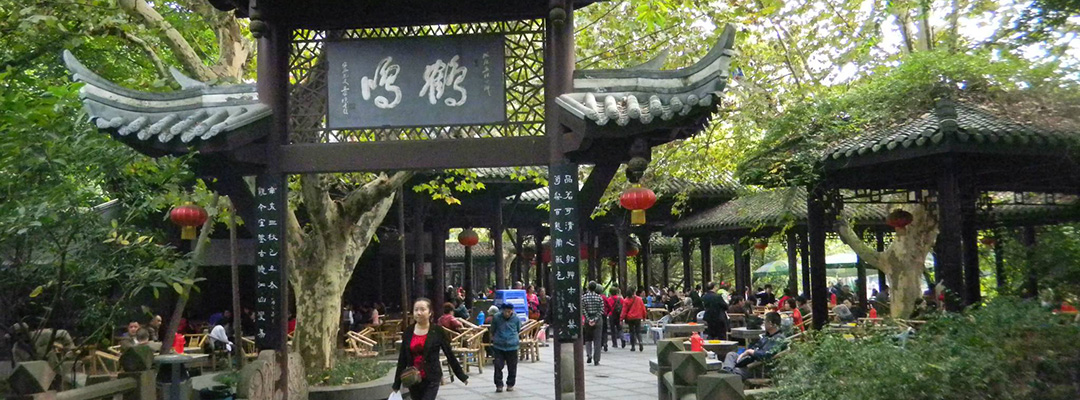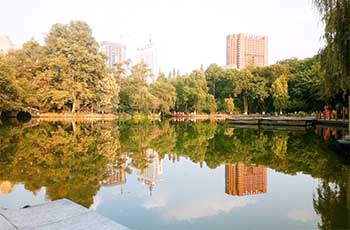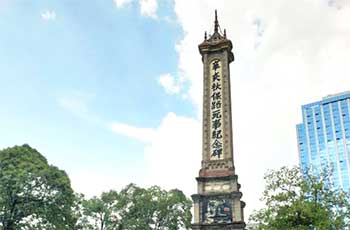Chengdu Renmin Park

Chengdu Renmin Park is a comprehensive garden for both the cultural heritages collection and entertainment. The locals in Chengdu often drink tea for relaxing here. You will never know what real lifestyle in the “Capital of Leisure” is like unless you visit Renmin Park. There are always crowds sitting in the shade of the park from when the sun rises. The best things to do here include going into a teahouse, ordering a cup of tea, reading for a whole afternoon, thinking about nothing, or chatting with some old friends. Enjoying the slow life in Chengdu, you may suddenly feel that you are leading a happy life.
- Chinese name: 成都人民公园 Chéng Dū Rén Mín Gōng Yuán
- Built in 1911
- Duration: 1-2 hours
- Entrance fee: free. RMB 12 per person for flower shows and RMB 8 per person for major festivals
- Opening hours: 06:30~22:00 in summer; 06:30~20:00 in winter
- Address: 12 Shaocheng Road, Qingyang District, Chengdu City
- Best time to visit: all year around
- How to get there: Bus 4, 5, 7, 13, 43, 47, 58, 64, 81, 85
Highlights of Chengdu Renmin Park
1. Jinshui Creek:
The source of Jinshui Creek is the Lotus Pond at the foot of the Western Hill in Renmin Park. The Creek runs along the inner path from the main entrance of the Park to the East Gate. The bed of Jinshui Creek is paved with little smooth pebbles and the banks of the Creek by cobble stones of different sizes. Along the banks peaches, willows, Filamental Flowering Crabapples, Wintersweets, privet and trees with red leaves have been planted. Scenes in different seasons vary, with pink peach blossoms and green willow leaves in spring, colorful fallen leaves in autumn and fragrant Wintersweets in winter. Mountains, rivers and creeks are combined together so well that you can appreciate the art work of nature.
 Artificial Lake
Artificial Lake 2. Artificial Lake:
Somewhat gourd-shaped, the Lake holds the simple but elegant Golden Fish Island and Yongju Teahouse. Willows, Cotton Rose Hibiscus, Filament Flowering Crabapple trees, peaches, and other trees, have been planted along the shores of the Lake. Seasonal flowers have been planted in six flower belts. The sight of the green mountains and blue waters here are really appealing. East Artificial Mountain and Artificial Lake are nowadays used as resorts to avoid the heat and ride boats in summer, and as sites for relaxing and visiting during the holidays by Chengdu residents.
3. Bonsai Garden:
Two features of the garden are restful walkways and a lotus pond in the garden. Along the shores of the pond are artificial hills decorated with Radix Ophiopogonis (Dwarf Lilyturf) and Azaleas. Growing in the pond are water lilies, lotuses, common Calla Lilies and Cyperus alternifolius (Umbrella Pandanus). Verdant trees and green grasses create a quiet environment in the Garden. Over 200 bonsai are on display, with over 20 of them being landscape bonsai and the rest being tree bonsai.
 Monument to the Martyrs in the autumn of Xinhai Year
Monument to the Martyrs in the autumn of Xinhai Year 4. Monument to the Martyrs in the autumn of Xinhai Year (1911 AD):
In the park stands the famously known Monument to the Martyrs in the autumn of Xinhai Year (1911 AD). In May and June 1911, to prevent the Qing Government from selling the construction rights of private Chuan-Han Railway and Yue-Han Railway to the bank consortium established by America, Britain, France and Germany for mortgage loans, people in Sichuan, Guangdong, Hunan and Hubei organized Leagues for Protecting the Railway and promoted the Railway Protection Movement. In September of the same year, Sichuan League for Protecting the Railway presented a petition in front of the Sichuan Government. Zhao Er’feng, governor-general of Sichuan, ordered to shoot against the masses in the petition with dozens of them dying on site. This move triggered armed resistance of all the people in Sichuan and resulted in the outbreak of the Wuchang Uprising. This modern historic monument was built in honor of the martyrs sacrificed in the Railway Protection Movement in the autumn of 1911.
Experience the Local Life Style:
1. Sip a cup of tea:
Teahouses and famous snack restaurants like Zhong Dumplings can be found in the park. The pleasant environment and scenery in the century-old park with its unique features helps build the time-honored brand into a garden restaurant where visitors can enjoy a cup of tea while gazing at the beautiful scenery.
2. Watch fish:
Visitors in the teahouses on Golden Fish Island can watch fish while tasting tea, making the Island a site with a taste for entertainment, watching fish and tasting tea.
Suggested route:
Main entrance, Jinshui Creek, Heming Teahouse, Artificial Lake, East Artificial Mountain, Shaochengyuan Teahouse, Shuangquan Building, Orchid Garden, Bonsai Garden, Children’s Park, Promenade for Rest, Monument to the Martyrs in the autumn of Xinhai Year (1911 AD), Jinshui Creek, Lotus Pond, Zhenliu Teahouse at West Artificial Mountain, West Gate on Xiaonan Street.
Drop us a line and we'll connect you with the top China expert in no time!